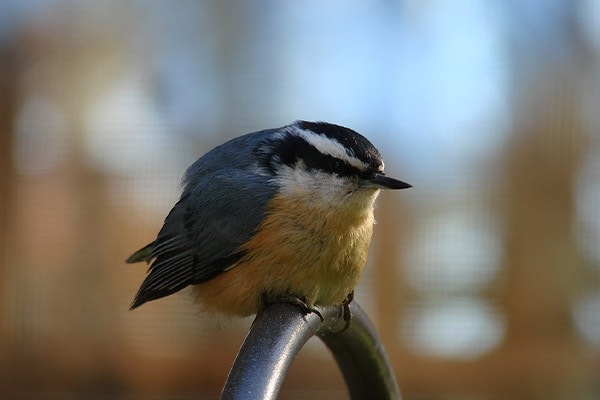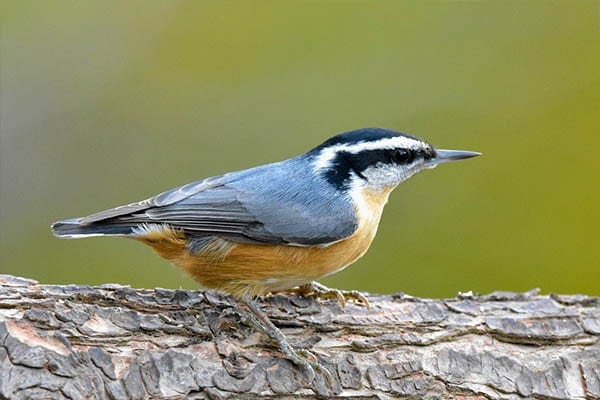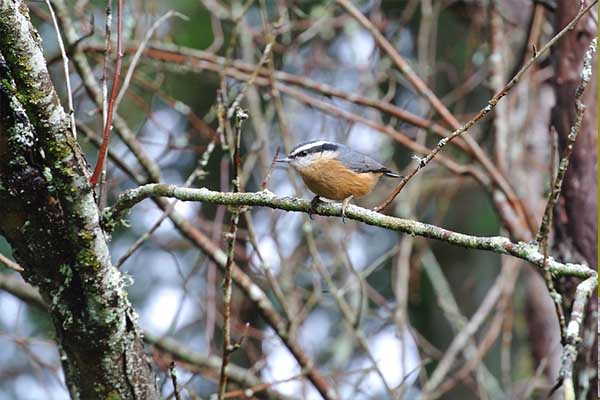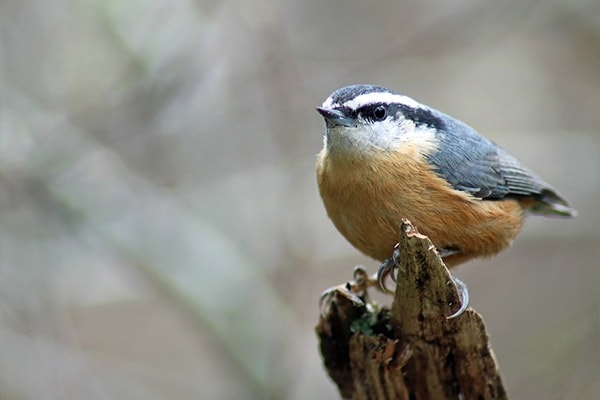
photo credit: Peggy Dyar from Pixabay
The Red-Breasted Nuthatch is an active, noisy bird, common in northern woodlands and western mountains. As their name implies, the birds feature a red breast and a beautiful grayish pattern in their back and wings. They are also usually seen to travel with other bird species like chickadees, kinglets, and woodpeckers.
In this article, we are going to cover a wide variety of topics related to the Red-Breasted Nuthatch, such as:
- How to identify them
- How, when, and where they migrate
- Their diet
- How and where they nest
- And much more…
So, without any more delay…
Let’s jump right into it and learn more about the Red-Breasted Nuthatch.
Red-breasted Nuthatch Facts
- Common Name: Red-breasted Nuthatch
- Scientific Name: Sitta canadensis
- Scientific Family: Sittidae
- Life Span: 6 years
- Size: 4.3 inches
- Wingspan: 7.1 to 7.9 inches
- Weight: 0.3 to 0.5 oz
- Conservation status: Least concern
How To Identify A Red-breasted Nuthatch
The Red-breasted Nuthatch is quite a small compact bird that measures 4.5 inches long. They feature a straight gray bill, black crown, and black eye-line with white supercilium. You’ll also notice that these birds have a white lower face and throat, blue-gray back and wing areas, reddish underparts, and a short bluish-gray tail.
Differences Between Male & Female

photo credit: Jack Bulmer from Pixabay
Male and female Red-breasted Nuthatches look very similar to each other. However, it has been noted that females have only slightly duller upperparts than males. There’s also a brown stripe around the eyes that seems to just merge into the color of her back.
Differences In Summer Plumage vs Winter Plumage
There’s no significant difference in the plumage of Red-breasted Nuthatches between summer and winter.
Red-breasted Nuthatch Sounds
Where You’ll See Red-breasted Nuthatches
Red-breasted Nuthatches are common across North America. The birds mainly breed in the southeast of Alaska, going to the south of Yukon, going across Canada to Newfoundland, and down to some parts of the US like the south of Oregon, northern California, Minnesota, Wisconsin, Michigan, and most of the northeastern part of the US including, New York, Massachusetts, Pennsylvania, and Connecticut.
Eastern populations are generally seen in deciduous woods in trees like aspen, oak, basswood, and maple. However, it’s found that these birds prefer wet, full-grown, and coniferous forests with spice, pine, larch, fir, and western red cedar trees.
There are also cases wherein the Red-breasted Nuthatches are found in more open habitats like orchards, parks, and plantations.
Red-breasted Nuthatch Migration Patterns

photo credit: JudaM from Pixabay
Red-breasted Nuthatches can either be resident, short-distance migrants, or irruptive migrants (birds that travel short distances but will move further if in large numbers).
Migration can be unpredictable as some populations don’t tend to migrate. Those in the north will likely travel more going south every year. However, other Red-breasted Nuthatches will only move southward when food supply is low in their wintering grounds.
There are also some cases where the birds can reach up to the Gulf Coast.
Diet and Feeding Preferences

photo credit: JudaM from Pixabay
Red-breasted Nuthatches can eat both animal and plant material, usually depending on the season.
When it’s summer, the birds would usually feed on insects such as beetles, caterpillars, spiders, flies, and ants. When insects are not available during the winter season, the birds will feed on various conifer seeds, including those cached from the previous year.
These birds are also frequent visitors of bird feeders and would eat peanuts, sunflower seeds, and suet.
Nesting Data
- Clutch Size: 2 - 8 eggs
- # of Broods: 1 brood
- Incubation Period: 12 - 13 days
- Nestling Period: 18 - 21 days
- Egg Description: Cream white dotted reddish-brown
Nesting
Red-breasted Nuthatches begin their courtship in early March, but nesting usually starts in May.
There are also cases when males, even without mates, would start to build and form several cavities at once to attract a female. Cavities are usually created and built in a rotten snag, often aspen, and require fairly softwood to form the nests. Sometimes, they would also use a natural cavity or an artificial nest box.
Both male and female pairs create the nests, but females build the nest inside. The nest is usually made using grass, pine needles, moss, bark fibers, and feathers. They’ll shape the nest like a cup, and then coat the inner and outer part of the nest hole opening with a sticky pitch.
Nuthatches occasionally use a bark piece to transport the pitch to the nest and then smear it on the hole opening. Then, they’ll usually fly directly into the hole, so they don’t get stuck on the pitch. This pitch is what will help protect their eggs from predators and opponents.
Red-breasted Nuthatch Behavior
Red-breasted Nuthatches use their powerful legs and claws to walk on tree trunks, hopping everywhere to explore the surroundings. They wander around the area to probe for food if the supply would be enough and can sustain for days.
These birds would also regularly store food under the barks, crevices, and ground during the fall in winter.
Nuthatches are aggressively territorial during the breeding season. The pair would often stick together throughout the season to defend their food supplies, and they sometimes merge with other large groups of various species during winter.
Tips for Birdwatchers On How To Attract Red-breasted Nuthatch
Red-breasted Nuthatches are found in some parts of the US. But they also travel across the United States, especially in winter. If you’re expecting the birds’ arrival in winter or if you’re located in their breeding grounds, then you’ll be happy to know that they are quite easy to attract.
Like most birds, you only need to satisfy their needs.
These birds prefer to eat from outlets, suet-feeders, hopper-type feeders. So, try to hang some in your backyard and fill them with peanuts, suet, sunflower seeds, and even live mealworms. If it’s during the breeding season, making your yard insect-friendly will be very helpful.
If you want to see them closer, try putting some of their favorite seeds on your hand and extend your hand outward. You’ll see these birds immediately fly in to eat. The best thing about this is that other birds might also come.
Threats To The Red-breasted Nuthatch

photo credit: Peggy Dyar from Pixabay
Red-breasted Nuthatches are considered the least concern in terms of conservation. The numbers are found to be increasing; however, it has been recorded that in some local areas, their habitats are decreasing, and so are their numbers.
Predators are very common for these birds. Some of their most common predators are hawks, merlins, owls, squirrels, jays, wrens, chipmunks, and even squirrels.
Fun & Interesting Facts
- As the name implies, Red-breasted Nuthatches are nut hatchers because they usually hatch nuts in tree crevices to open them.
- Red-breasted Nuthatches line their nest openings with a sticky pitch to protect their eggs from predators.
- They are one of the noisiest woodland birds during spring.
- They have an enlarged hin toe and a short tail that helps them climb up and down trees.
- These birds sometimes steal nest-lining materials from other birds’ nests.
- The oldest recorded Red-breasted Nuthatch was seven years and six months old.
Explore More Species in This Family
- White-breasted Nuthatch
- Pygmy Nuthatch
- Brown-headed Nuthatch
The post Red-breasted Nuthatch: Bird Identification, Habits, Facts, Nesting appeared first on BirdInformer.com.
from BirdInformer.com https://ift.tt/2Pm8eGf

No comments:
Post a Comment